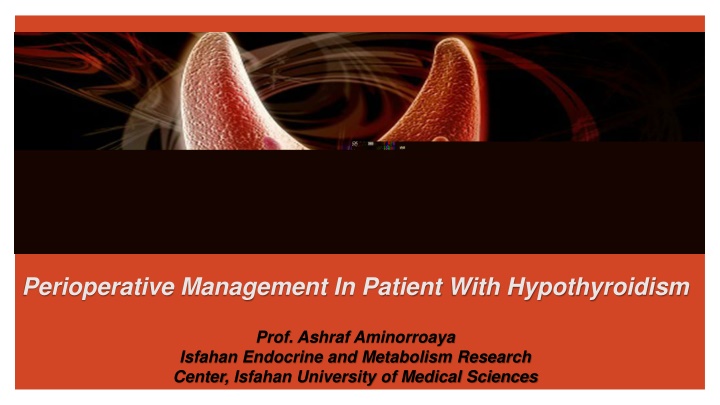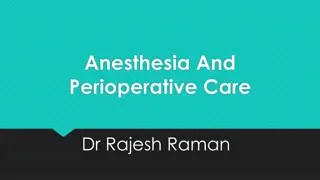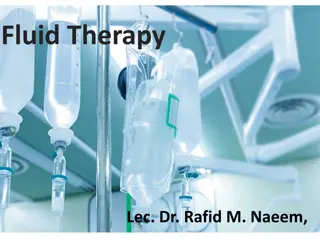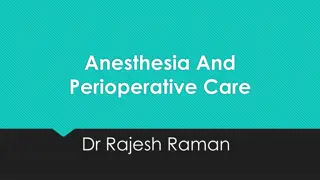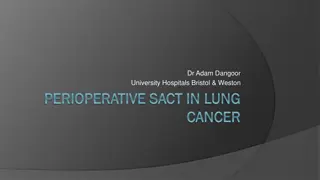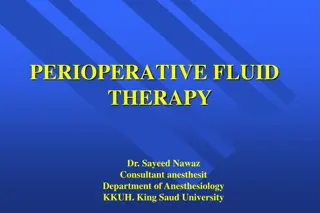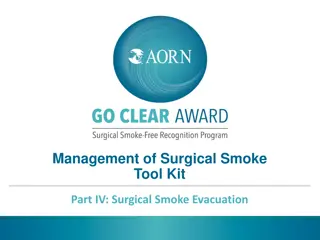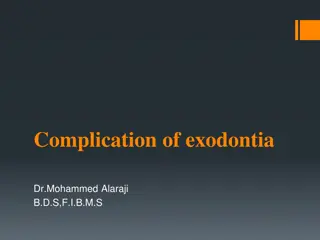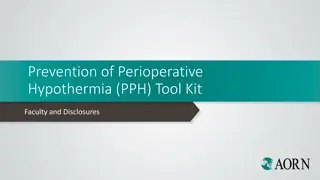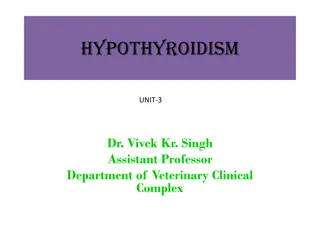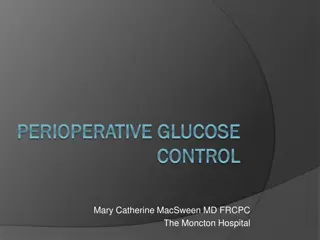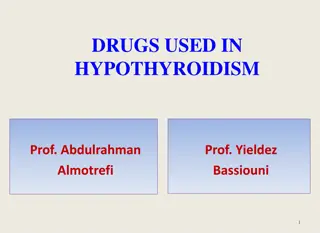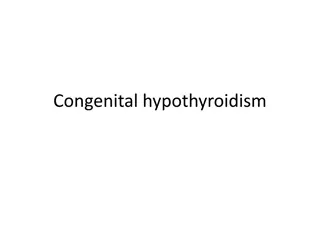Perioperative Management in Patients with Hypothyroidism
Hypothyroidism is a prevalent endocrine disorder, particularly in women and the elderly. Understanding the implications of hypothyroidism in perioperative settings is crucial for effective management during surgeries. The article discusses the prevalence, perioperative considerations, and cardiovascular impacts of hypothyroidism, providing insights into optimal patient care.
Download Presentation

Please find below an Image/Link to download the presentation.
The content on the website is provided AS IS for your information and personal use only. It may not be sold, licensed, or shared on other websites without obtaining consent from the author.If you encounter any issues during the download, it is possible that the publisher has removed the file from their server.
You are allowed to download the files provided on this website for personal or commercial use, subject to the condition that they are used lawfully. All files are the property of their respective owners.
The content on the website is provided AS IS for your information and personal use only. It may not be sold, licensed, or shared on other websites without obtaining consent from the author.
E N D
Presentation Transcript
Perioperative Management In Patient With Hypothyroidism Prof. Ashraf Aminorroaya Isfahan Endocrine and Metabolism Research Center, Isfahan University of Medical Sciences
Prevalence of Hypothyroidism Hypothyroidism is a common endocrinopathy, and is more prevalent in women and with increasing age. Primary hypothyroidism accounts for 95% of all cases. The overall prevalence of hypothyroidism was 4.8%)Subclinical = 3.1%(in men and 12.8% )Subclinical = 8.6%( in women in Isfahan, Iran, 2006. Within a 6-year follow-up, the incidence rate of hypothyroidism was 3.3 in women and 2.1 in men per 1000 (person-year) Higher TPOAb concentration is its strong predictor of this incident. Eur J Med Res (2017) 22:21 Arch Iran Med. 2009 May;12(3):262-70
Perioperative Management In Patient With Hypothyroidism Perioperative Management In Patient With Hypothyroidism A significant number of patients who are undergoing surgery may have concomitant thyroid disease. Due to the effects of thyroid hormone throughout the body, the effects of thyroid dysfunction are may complicate surgical procedures and postoperative recovery. *Palace MR. Perioperative Management of Thyroid Dysfunction. Health service Insight 2017:1-5
Should perioperative TSH be measured Should perioperative TSH be measured routinely? routinely? No Routine screening to detect thyroid disease is not indicated in patients. *where there is no index of suspicion hypothyroidism . *Patients with taking thyroid medication on stable dose and euthyroidism was documented within the past 3 to 6 months. * Manzullo Fe, Ross Ds. Nonthyroid surgery in the patient with thyroid disease. 2018: Available at https://www.uptodate.com/contents /nonthyroid-surgery-in-the-patient-with-thyroid-disease
Should perioperative TSH be Should perioperative TSH be measured? measured? YES * History and physical examination are suggestive of thyroid disease. * Poorly controlled symptom in patient with known hypothyroidism. * Manzullo Fe, Ross Ds. Nonthyroid surgery in the patient with thyroid disease. 2018: Available at https://www.uptodate.com/contents /nonthyroid-surgery-in-the-patient-with-thyroid-disease
Cardiovascular System Cardiovascular System *Decrease the Heart Rate * Decrease the contractility * Decrease the cardiac output (30-50%) #ECG Abnormalities: Slow Heart Rate Long QT Interval and Ventricular Tachycardia Nonspecific ST Change Low Voltage * Zaib H, Shan E. Undetected hypothyroidism and its anesthetic implications . Anesthesia, Pain & Intensive Care. 2012:16(2). 205-10 0
Cardiovascular Cardiovascular System ( System (cont.) cont.) Increase of systemic vascular resistance (Decrease the direct action of T3 on smooth muscle of the blood vessels and Increase the systolic BP) Catecholamine levels are generally within normal limits, ?-adrenergic receptor function is depressed and results in an imbalance of ? and adrenergic activity, with a predominating ? adrenergic activity. Tendency to hypotension when expose to the anesthetic agents (Impairment of baroreceptor function) Increase the risk of coronary events (Increase cholesterol level and abnormality in coagulation parameters even in subclinical hypothyroidism) * Zaib H, Shan E. Undetected hypothyroidism and its anesthetic implications . Anesthesia, Pain & Intensive Care. 2012:16(2). 205-10
Respiratory System Respiratory System Decrease in hypoxic ventilatory drive (no increase in minute ventilation even at low alveolar oxygen tension) Impaired Hypercapneic ventilatory drive Diminished diffusing capacity for carbon monoxide low maximal breathing capacity Respiratory muscle weakness * Zaib H, Shan E. Undetected hypothyroidism and its anesthetic implications . Anesthesia, Pain & Intensive Care. 2012:16(2). 205-10
Respiratory Respiratory System ( System (cont.) cont.) Sleep apnea (can adversely influence surgical outcome or make postoperative extubation problematic) Direct obstruction of the upper airway (increased tongue size) Decrease the surfactant production Decrease drug metabolism such as sedatives and anesthetics (precipitate respiratory failure) *Zaib H, Shan E. Undetected hypothyroidism and its anesthetic implications . Anesthesia, Pain & Intensive Care. 2012:16(2). 205-10
Renal Function Renal Function Decrease Renal Perfusion Decrease Atrial Natriuretic Factor Decrease Activity of RAAS Hyponatremia Increase ADH level *Zaib H, Shan E. Undetected hypothyroidism and its anesthetic implications . Anesthesia, Pain & Intensive Care. 2012:16(2). 205-10
Renal Renal Function ( Function (cont.) cont.) Worsening of Renal Function (Due to Intraoperative hypotension) None pitting edema ( increase the capillary permeability and shift of water and albumin and deposition of glycosaminoglycans in severe hypothyroidism) There have been some reports in the literature of hypothyroidism presenting as chronic renal failure, resolving completely with restoration of euthyroidism *Zaib H, Shan E. Undetected hypothyroidism and its anesthetic implications . Anesthesia, Pain & Intensive Care. 2012:16(2). 205-10
Hemopoietic Hemopoietic and Coagulation Systems and Coagulation Systems Anemia Decrease of erythropoiesis (low metabolic rate, decreased oxygen consumption and erythropoietin level) Iron deficiency Menorrhagia Pernicious anemia Few changes in other blood cellular elements *Zaib H, Shan E. Undetected hypothyroidism and its anesthetic implications . Anesthesia, Pain & Intensive Care. 2012:16(2). 205-10
Coagulation System Coagulation System Decrease in plasma factor VIII Acquired von Willebrand s disease Hemorrhagic tendency little impact on platelet counts but qualitative defect in platelet function * Zaib H, Shan E. Undetected hypothyroidism and its anesthetic implications . Anesthesia, Pain & Intensive Care. 2012:16(2). 205-10
Coagulation System Coagulation System Reduced clearance of vitamin K-dependent clotting factors such as factor II, VII, and X results in higher warfarin requirements during hypothyroidism and falling requirement during treatment with thyroid hormone. *Zaib H, Shan E. Undetected hypothyroidism and its anesthetic implications . Anesthesia, Pain & Intensive Care. 2012:16(2). 205-10
Gastrointestinal System Gastrointestinal System Decreased GI motility: Increase the tendency for postoperative ileus This is of increased concern considering that postoperative pain management regimens commonly use opioids which independently promote constipation. Constipation *Palace MR. Perioperative Management of Thyroid Dysfunction. Health service Insight 2017:1-5
Myxedema Coma Myxedema Coma A rare and dangerous complication of surgery in hypothyroid patients The mortality as high as 80% Manifestations: altered mental status (coma or seizure), and hypothermia, bradycardia, hyponatremia, heart failure, and hypopnea It is commonly associated with a precipitant such as surgery, infection, cold exposure, and administration of sedatives. *Palace MR. Perioperative Management of Thyroid Dysfunction. Health service Insight 2017:1-5
Recommendations For Recently Diagnosed Hypothyroid Patients Recommendations For Recently Diagnosed Hypothyroid Patients Surgical outcomes vary with the degree of underlying hypothyroidism. Management of patients with recently diagnosed hypothyroidism who require surgery is based upon observational data and clinical experience . * Manzullo Fe, Ross Ds. Nonthyroid surgery in the patient with thyroid disease. 2018: Available at https://www.uptodate.com/contents /nonthyroid-surgery-in-the-patient-with-thyroid-disease
Mild Mild H Hypothyroidism ypothyroidism Includes patients with subclinical hypothyroidism : biochemically as a normal serum free T4 concentration in the presence of an elevated serum TSHconcentration. There are few data on surgical outcomes in subclinical hypothyroid patients * Manzullo Fe, Ross Ds. Nonthyroid surgery in the patient with thyroid disease. 2018: Available at https://www.uptodate.com/contents /nonthyroid-surgery-in-the-patient-with-thyroid-disease
There were no significant differences in primary outcomes (major adverse cardiovascular events) and secondary outcomes such as wound problems, mediastinitis, leg infection, respiratory complications, delirium, or reoperation during the same hospitalization
Recommendations for Recommendations for subclinical subclinical hypothyroidism Patients hypothyroidism Patients Based upon the studies, we suggest not postponing surgery in patients with subclinical hypothyroidism * Manzullo Fe, Ross Ds. Nonthyroid surgery in the patient with thyroid disease. 2018: Available at https://www.uptodate.com/contents /nonthyroid-surgery-in-the-patient-with-thyroid-disease
Moderate Moderate Hypothyroidism Hypothyroidism Overt hypothyroidism (elevated TSH, low free T4) without the features of severe hypothyroidism Surgical Outcomes Several studies have investigated the safety of general anesthesia and surgery in patients with untreated or inadequately treated hypothyroidism. * Manzullo Fe, Ross Ds. Nonthyroid surgery in the patient with thyroid disease. 2018: Available at https://www.uptodate.com/contents /nonthyroid-surgery-in-the-patient-with-thyroid-disease
Hypothyroid patients had more preoperative risk factors but did not differ as a group from controls with regard to duration of surgery or anesthesia, lowest temperature and BP recorded during surgery, need for vasopressors, time to extubation, fluid and electrolyte imbalances, incidence of arrhythmias, pulmonary and myocardial infarction, sepsis, need for postoperative respiratory assistance, bleeding complications, or time to hospital dismissal. Analysis of subsets of hypothyroidism (thyroxine level, <1 , <3 , and > 3 /dL) also failed to disclose any significant differences compared with matched controls. Among patients with mild or moderate hypothyroidism, we found no evidence to justify deferring needed surgery until the hypothyroidism has been corrected.
https://doi.org/10.1016/j.arth.2017.10.053 . Result A total of 2,369,594 primary TKAs were identified between 2005 and 2014. After age and gender matching, each cohort consisted of 98,555 patients. Hypothyroidism was associated with greater odds of postoperative complications compared to matched controls (odds ratio 1.367, 95% confidence interval 1.322-1.413). The 90-day incidence of multiple postoperative medical and surgical complications, including periprosthetic joint infection, was higher among patients with hypothyroidism.Day of surgery an 90-day episode of care costs were significantly higher in the hypothyroidism cohort.
for overt overt hypothyroidism hypothyroidism Patients Recommendations Recommendations for Patients Elective Surgery state is achieved Elective surgery is best postponed until a euthyroid * Manzullo Fe, Ross Ds. Nonthyroid surgery in the patient with thyroid disease. 2018: Available at https://www.uptodate.com/contents /nonthyroid-surgery-in-the-patient-with-thyroid-disease ,
Recommendations for overt hypothyroidism Patients Urgent Surgery Undergo surgery without delay. Levothyroxine should be started preoperatively. Young patients are started on close to full replacement doses of levothyroxine (1.6 mcg/kg daily), older patients or patients with cardiopulmonary disease are started on 25 to 50 mcg daily with an increase in dose every 2 to 6 weeks. * Manzullo Fe, Ross Ds. Nonthyroid surgery in the patient with thyroid disease. 2018: Available at https://www.uptodate.com/contents /nonthyroid-surgery-in-the-patient-with-thyroid-disease
Urgent surgery There should be increased awareness of the possibility of minor postoperative complications such as intraoperative hypotension, gastrointestinal and neuropsychiatric complication, less likely to be febrile in postoperative infection. *Palace MR. Perioperative Management of Thyroid Dysfunction. Health service Insight 2017:1-5
Severe Hypothyroidism Severe Hypothyroidism Includes patients with: myxedema coma; with severe clinical symptoms of chronic hypothyroidism such as altered mentation, pericardial effusion, or heart failure; or those with very low levels of total thyroxine (T4) (eg, less than 1.0 mcg/dL) or free T4 (eg, less than 0.5 ng/dL) * Manzullo Fe, Ross Ds. Nonthyroid surgery in the patient with thyroid disease. 2018: Available at https://www.uptodate.com/contents /nonthyroid-surgery-in-the-patient-with-thyroid-disease.
Outcome in severe hypothyroidism Outcome in severe hypothyroidism Based on the results of the some case reports: 1- Intraoperative hypotension 2- Cardiovascular collapse 3- Extreme sensitivity to opioids, sedatives, and anesthesia 4- Myxedema Coma (Rare) * Manzullo Fe, Ross Ds. Nonthyroid surgery in the patient with thyroid disease. 2018: Available at https://www.uptodate.com/contents /nonthyroid-surgery-in-the-patient-with-thyroid-disease.
Management Management in severe hypothyroidism in severe hypothyroidism Elective surgery Today, there is a rare condition and these patients should be considered as a very high risk patients. Elective surgery should be delayed until hypothyroidism has been treated. * Manzullo Fe, Ross Ds. Nonthyroid surgery in the patient with thyroid disease. 2018: Available at https://www.uptodate.com/contents /nonthyroid-surgery-in-the-patient-with-thyroid-disease.
Emergent Surgery Thyroid hormone levels should be normalized as rapidly as possible Using IV levothyroxine in a loading dose of 200 to 500 g followed by 50 to 100 g IV daily T3 is given simultaneously in a dose of 5 to 20 mcg IV followed by 2.5 to 10 mcg every eight hours depending upon the patient's age and coexistent cardiac risk factors. * Manzullo Fe, Ross Ds. Nonthyroid surgery in the patient with thyroid disease. 2018: Available at https://www.uptodate.com/contents /nonthyroid-surgery-in-the-patient-with-thyroid-disease.
Oral administration of T4 through NG tube has proved to be equally effective with a drawback that gastric atony may prevent absorption and put the patient at risk for aspiration. *P. Dutta, A. Bhansali, S. Masoodi, S. Bhadada, N. Sharma, and R. Rajput, Predictors of outcome in myxoedema coma: a study from a tertiary care centre, Critical Care, vol. 12, no. 1, p. R1, 2008.
Dutta and colleagues compared 500 g of oral loading dose of T4 with 150 g of maintenance dose orally and 200 g of T4 intravenously followed by 100 g T4 intravenously until they regained their vital functions and were able to take oral medications in patients with myxedema crisis Didn t find any difference in outcome among the patients. * P. Dutta, A. Bhansali, S. Masoodi, S. Bhadada, N. Sharma, and R. Rajput, Predictors of outcome in myxoedema coma: a study from a tertiary care centre, Critical Care, vol. 12, no. 1, p. R1, 2008.
Adrenal Insufficiency Adrenal Insufficiency Rarely, Addison's disease will be present in a patients with primary hypothyroidism (due to Hashimoto's thyroiditis) or with central hypothyroidism ( inadequate pituitary adrenal reserve). If the status of the pituitary adrenal axis is uncertain and deficiency is considered likely, patients should be given stress doses of corticosteroids until the integrity of the axis is ascertained. If the clinical situation permits (ie, surgery can be delayed for an hour), a cosyntropin stimulation test should be performed prior to administering steroids. If the results of the cosyntropin test are normal, stress steroids are not needed and can be discontinued if already given. * Manzullo Fe, Ross Ds. Nonthyroid surgery in the patient with thyroid disease. 2018: Available at https://www.uptodate.com/contents /nonthyroid-surgery-in-the-patient-with-thyroid-disease.
If there is any suspicion for concurrent adrenal insufficiency, glucocorticoids should be administered in stress doses prior to or together with thyroid hormone. *Palace MR. Perioperative Management of Thyroid Dysfunction. Health service Insight 2017:1-5
Management Of Patient Who Taking Chronic T Management Of Patient Who Taking Chronic T4 4 Medication Medication If the patient is to fast on the day of surgery, the patient may miss the dose of levothyroxine that day, as it has a long half-life of approximately 7 days. If oral medications can not be given postoperatively, the dose may be missed for several days. However, if there is still no ability to administer the drug enterally after 5 days, intravenous (IV) levothyroxine should be administered at a dose between 60% - 80% of the oral dose. * Palace MR. Perioperative Management of Thyroid Dysfunction. Health service Insight 2017:1-5
Conclusion( Conclusion(1 1) ) Management of patients with recently diagnosed hypothyroidism who require surgery is based upon observational data and clinical experience. Mild Elective not postponing surgery Emergent
Conclusion( Conclusion(2 2) ) postponed until a euthyroid state is achieved Elective Moderate Undergo surgery without delay Emergent Levothyroxine should be started preoperatively.
Conclusion( Conclusion(3 3) ) postponed until a euthyroid state is achieved Elective Severe Thyroid hormone levels should be normalized as rapidly as possible. Emergent Glucocorticoids should be administered in stress doses, if there is any suspicion for concurrent adrenal insufficiency.
